 W
WThe Aggie Bonfire was a long-standing annual tradition at Texas A&M University as part of the college rivalry with the University of Texas at Austin. For 90 years, Texas A&M students—known as Aggies—built a bonfire on campus each autumn, known to the Aggie community simply as "Bonfire". The event symbolized Aggie students' "burning desire to beat the hell outta t.u.", a derogatory nickname for the University of Texas.
 W
WAllantide, also known as Saint Allan's Day or the Feast of Saint Allan, is a Cornish festival that was traditionally celebrated on the night of 31 October, as well as the following day time, and known elsewhere as Allhallowtide. The festival in Cornwall is the liturgical feast day of St Allan, who was the bishop of Quimper in the sixth century. As such, Allantide is also known as Allan Night and Allan Day. The origins of the name Allantide also probably stem from the same sources as Hollantide and Hallowe'en itself.
 W
WAllendale, often marked on maps as Allendale Town, is a village and civil parish in south west Northumberland, England. At the 2001 census, the parish had a population of 2,120, decreasing to 2,021 at the 2011 Census. Allendale is within the North Pennines Area of Outstanding Natural Beauty (AONB); the second largest of the 40 AONB's in England and Wales. The local economy is predominantly based on agriculture and tourism, although of late it has become a popular commuter town for Newcastle upon Tyne.
 W
WThe Anastenaria, is a traditional barefoot fire-walking ritual with ecstatic dance performed in some villages in Northern Greece and Southern Bulgaria. The communities which celebrate this ritual are descended from refugees who entered Greece from Eastern Thrace following the Balkan Wars of 1911–12 and the Population exchange between Greece and Turkey in 1923.
 W
WThe badnjak, also called veseljak, is a tree branch or entire tree that is central to Serbian Christmas celebrations. It is placed on a fire on Christmas Eve and its branches are later brought home by worshipers. The tree from which the badnjak is cut, preferably a young, straight and undamaged Austrian oak, is ceremonially felled early on the morning of Christmas Eve. The felling, preparation, bringing in, and laying on the fire, are surrounded by elaborate rituals, with many regional variations. The burning of the log is accompanied by prayers that the coming year brings food, happiness, love, luck, and riches. The log burns on throughout Christmas Day, when the first visitor strikes it with a poker or a branch to make sparks fly, while wishing that the family's happiness and prosperity be as abundant as the sparks. As most Serbs today live in towns and cities, the badnjak is often symbolically represented by a cluster of oak twigs with brown leaves attached, with which the home is decorated on Christmas Eve.
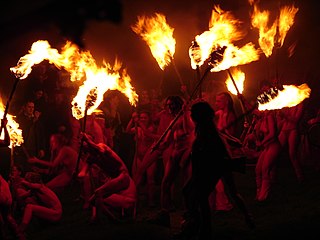 W
WBeltane Fire Festival is an annual participatory arts event and ritual drama, held on 30 April on Calton Hill in Edinburgh.
 W
WThe Biikebrennen, Biikebrånen or Pers Awten is an annual bonfire night celebration held on 21 February in North Frisia, in the German state of Schleswig-Holstein and in Southern Jutland in Denmark.
 W
WBonfire Night is a name given to various annual celebrations characterised by bonfires and fireworks. The event celebrates different traditions on different dates, depending on the country. Some of the most popular instances include Guy Fawkes Night in Great Britain, which is also celebrated in some Commonwealth countries; Northern Ireland's Eleventh Night, and 5 November in Newfoundland and Labrador. In various parts of Ireland, Bonfire Nights are held on St John's Eve, Bealtaine eve and Halloween. In Scandinavia it is known as Walpurgis Night and in Denmark also sankthansaften. St John's Eve is also a very important celebration in Spain and Northern Portugal. Several other cultures also include night-time celebrations involving bonfires and/or fireworks.
 W
WBurning Man is an event held annually since 1986 in the western United States. Since 1991, the event has been located at Black Rock City, a temporary city erected in the Black Rock Desert of northwestern Nevada. The event is held approximately 100 miles (160 km) north-northeast of Reno. As outlined by Burning Man co-founder Larry Harvey in 2004, the event is guided by these ten principles: radical inclusion, gifting, decommodification, radical self-reliance, radical self-expression, communal effort, civic responsibility, leaving no trace, participation, and immediacy. The event derives its name from its culmination, the symbolic burning of a large wooden effigy, referred to as "The Man," that occurs on the Saturday evening before Labor Day.
 W
WChaharshanbe Suri is an Iranian festival celebrated on the eve of the last Wednesday before Nowruz.
 W
WThe cremà is the act of setting fire to a falla monument, made from materials such as cardboard and wood, during the festivities of several towns in the Valencian community, Spain. A similar celebration is the Bonfires of Saint John from Alicante, also in the Valencian community. In all cases the celebration ends with the burning of the monuments.
 W
WThe Cremation of Care is an annual ritual production written, produced, and performed by and for members of the Bohemian Club and staged at the Bohemian Grove near Monte Rio, California at a small artificial lake amid a private old-growth grove of Redwood trees.
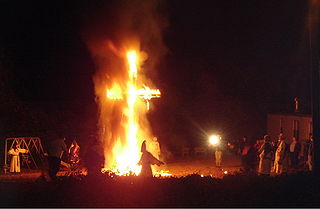 W
WCross burning or cross lighting is a practice associated with the Ku Klux Klan, although it long predates the Klan's inception – as far back as Peter of Bruys, who burned crosses in protest at the veneration of crosses. Since the early 20th century, the Ku Klux Klan burned crosses on hillsides as a way to intimidate and threaten African Americans and other people of color.
 W
WDelting Up Helly Aa is the final festival in the Shetland Islands' Up Helly Aa calendar, taking place on the third Friday of March in the parish of Delting.
 W
WA dhuni is a sacred site represented as a cleft in the ground. This cleft is emblematic of the yoni or female vulva and generative organ. A dhuni therefore represents a site of worship dedicated to Shakti.
 W
WDiwali is a festival of lights and one of the major festivals celebrated by Hindus, Jains and Sikhs. The festival usually lasts five days and is celebrated during the Hindu lunisolar month Kartika. One of the most popular festivals of Hinduism, Diwali symbolizes the spiritual "victory of light over darkness, good over evil, and knowledge over ignorance". The festival is widely associated with Lakshmi, goddess of prosperity, with many other regional traditions connecting the holiday to Sita and Rama, Vishnu, Krishna, Yama, Yami, Durga, Kali, Hanuman, Ganesha, Kubera, Dhanvantari, or Vishvakarman. Furthermore, it is, in some regions, a celebration of the day Lord Rama returned to his kingdom Ayodhya with his wife Sita and his brother Lakshmana after defeating Ravana in Lanka and serving 14 years of exile.
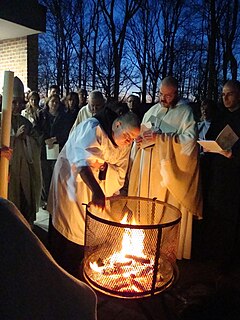 W
WEaster fires are typically bonfires lit at Easter as part of liturgical and secular celebrations.
 W
WIn Northern Ireland, the Eleventh Night or 11th Night refers to the night before the Twelfth of July, a yearly Ulster Protestant celebration. On this night, large towering bonfires are lit in many Protestant/loyalist neighbourhoods in Northern Ireland and are often accompanied by street parties and loyalist marching bands. The bonfires are mostly made up of wooden pallets and tyres, with the Irish tricolour being burnt. The bonfires are lit to celebrate (1688) and victory of Protestant king William of Orange over Catholic king James II at the Battle of the Boyne (1690), which began the Protestant Ascendancy in Ireland. The event has been condemned for displays of sectarian or ethnic hatred, anti-social behaviour, and for the damage and pollution caused by the fires. The flag of the Republic of Ireland, Irish nationalist/republican symbols, Catholic symbols, and effigies, are burnt on many bonfires. There have been attempts to make the event more family-friendly and environmentally-friendly. It is also known as "bonfire night", in common with other events in which bonfires are lit.
 W
WThe Falles is a traditional celebration held annually in commemoration of Saint Joseph in the city of Valencia, Spain. The five main days celebrated are from March 15–19, while the Mascletà, a pyrotechnic spectacle of firecracker detonation and fireworks display, takes place every day from March 1–19. The term Falles refers to both the celebration and the monuments burnt during the celebration. A number of towns in the Valencian Community have similar celebrations inspired by the original Falles de València celebration. The Falles festival was added to UNESCO's intangible cultural heritage of humanity list on 30 November 2016.
 W
WThe Falles or Fallas of Alzira are a celebration in commemoration of Saint Joseph in the town of Alzira, which, like the Falles in Valencia and other towns of the Valencian Community, takes place in March. Apart from the Fallas in Valencia, those celebrated in Alzira are the most important festival of this type, due to their century-old tradition, their continuing popularity, and the fact that they have the largest number of active participants (fallers), "commissions" and "falla monuments" (falles), seventy of which are erected in the streets of the town. The Falles of Alzira have been declared an Event of National Tourist Interest.
 W
WThe fire knife is a traditional Samoan cultural implement that is used in ceremonial dances. It was originally composed of a machete wrapped in towels on both ends with a portion of the blade exposed in the middle. Tribal performers of fire knife dancing dance while twirling the knife and doing other acrobatic stunts. The towels are set afire during the dances, hence the name.
 W
WFirewalking is the act of walking barefoot over a bed of hot embers or stones.
 W
WGolowan is the Cornish language word for the Midsummer celebrations in Cornwall, UK; widespread prior to the late 19th century and most popular in the Penwith area and in particular Penzance and Newlyn. The celebrations were centred on the lighting of bonfires and fireworks and the performance of associated rituals. The midsummer bonfire ceremonies were revived at St Ives in 1929 by the Old Cornwall Society and since then spread to other societies across Cornwall, as far as Kit Hill near Callington. Since 1991 the Golowan festival in Penzance has revived many of these ancient customs and has grown to become a major arts and culture festival; its central event 'Mazey Day' now attracts tens of thousands of people to the Penzance area in late June.
 W
WGozan no Okuribi (五山送り火), more commonly known as Daimonji (大文字), is a festival in Kyoto, Japan. It is the culmination of the Obon festival on August 16, in which five giant bonfires are lit on mountains surrounding the city. It signifies the moment when the spirits of deceased family members, who are said to visit this world during O-Bon, are believed to be returning to the spirit world—thus the name Okuribi .
 W
WGuy Fawkes Night, also known as Guy Fawkes Day, Bonfire Night and Fireworks Night, is an annual commemoration observed on 5 November, primarily in the United Kingdom. Its history begins with the events of 5 November 1605 O.S., when Guy Fawkes, a member of the Gunpowder Plot, was arrested while guarding explosives the plotters had placed beneath the House of Lords. Celebrating the fact that King James I had survived the attempt on his life, people lit bonfires around London; and months later, the introduction of the Observance of 5th November Act enforced an annual public day of thanksgiving for the plot's failure.
 W
WHanukkah is a Jewish festival commemorating the recovery of Jerusalem and subsequent rededication of the Second Temple at the beginning of the Maccabean revolt against the Seleucid Empire in the 2nd century BCE. It is also known as the Festival of Lights.
 W
WHoli is a popular ancient Hindu festival, also known as the "festival of spring", the "festival of colours", and the "festival of love". The festival signifies the triumph of good over evil. It originated and is predominantly celebrated in India, but has also spread to other regions of Asia and parts of the Western world through the diaspora from the Indian subcontinent.
 W
WHolika Dahan also Kamudu pyre is celebrated by burning Holika, an asura. For many traditions in Hinduism, Holi celebrates the killing of Holika in order to save Prahlad, a devotee of God Vishnu and thus Holi gets its name. In olden days, people used to contribute a piece of wood or two for the Holika bonfire, and this represents Holika being consumed by the fire in which she tried to kill her nephew Prahlad. A similar holiday is Holi where people get to gather and often repair broken relationships.
 W
WIn the Vedic Hinduism, a homa also known as havan, is a fire ritual performed on special occasions by a Hindu priest usually for a homeowner. The grihasth keeps different kinds of fire including one to cook food, heat his home, amongst other uses; therefore, a Yagya offering is made directly into the fire. A homa is sometimes called a "sacrifice ritual" because the fire destroys the offering, but a homa is more accurately a "votive ritual". The fire is the agent, and the offerings include those that are material and symbolic such as grains, ghee, milk, incense and seeds.
 W
WHüttenbrennen, sometimes also referred to as Burgbrennen, is an old-fashioned bonfire custom in many part of the Eifel mountains in Germany. It is celebrated every year on "Straw Sunday", the first Sunday after Shrove Tuesday, also observed as Funkensonntag.
 W
WKupala Night,, also called Ivanа-Kupala, is a traditional Slavic holiday that was originally celebrated on the shortest night of the year, which is on 21-22 or 23-24 of June and in Eastern Slavic countries according to traditional Julian calendar on the night between 6 to 7 July. Calendar-wise, it is opposite to the winter holiday Koliada. The celebration relates to the summer solstice when nights are the shortest and includes a number of Slavic rituals.
 W
WLag BaOmer, also Lag B'Omer, is a Jewish religious holiday celebrated on the 33rd day of the Counting of the Omer, which occurs on the 18th day of the Hebrew month of Iyar.
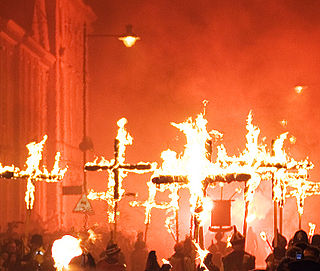 W
WLewes Bonfire or Bonfire, for short, describes a set of celebrations held in the town of Lewes, Sussex that constitute the United Kingdom's largest and most famous Bonfire Night festivities, with Lewes being called the bonfire capital of the world.
 W
WLohri is a popular Punjabi winter folk festival celebrated primarily in the Punjab region. The significance and legends about the Lohri festival are many and these link the festival to the Punjab region. It is believed by many that the festival commemorates the passing of the winter solstice. Lohri marks the end of winter, and is a traditional welcome of longer days and the sun's journey to the northern hemisphere by Sikhs and Hindus in the Punjab region of the Indian subcontinent. It is observed the night before Makar Sankranti, also known as Maghi, and according to the solar part of the lunisolar Bikrami calendar and typically falls about the same date every year.
 W
WMagh Bihu (also called Bhogali Bihu (
 W
WA mascletà is a pyrotechnic event characterized by the achievement of a noisy and rhythmic composition that features, particularly during daytime, in street festivities; it is typical of the Valencian Community (Spain). It gets its name from the masclets that are tied by a wick to form a line or firework display. These are usually fastened at a medium height with ropes or raised by cannons.
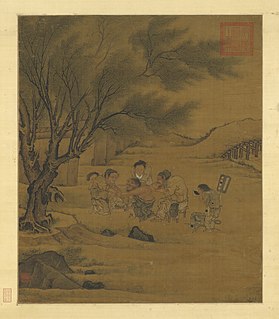 W
WMoxibustion is a traditional Chinese medicine therapy which consists of burning dried mugwort (wikt:moxa) on particular points on the body. It plays an important role in the traditional medical systems of China, Tibet, Japan, Korea, Vietnam, and Mongolia. Suppliers usually age the mugwort and grind it up to a fluff; practitioners burn the fluff or process it further into a cigar-shaped stick. They can use it indirectly, with acupuncture needles, or burn it on the patient's skin.
 W
WNeed-fire, or Wild-fire is a term used in folklore to denote a superstition which survived in the Scottish Highlands until a recent date.
 W
WThe New Fire Ceremony was an Aztec ceremony performed once every 52 years—a full cycle of the Aztec “calendar round”—in order to stave off the end of the world. The calendar round was the combination of the 260-day ritual calendar and the 365-day annual calendar. The New Fire Ceremony was part of the “Binding of the Years” tradition among the Aztecs.
 W
WNewroz or Nawroz is the celebration of the arrival of spring and new year in Kurdish culture. It is celebrated by all Iranic peoples Before the Islamization of the Iranic peoples, they followed Zoroastrianism. In Zoroastrian doctrine, fire is a symbol of light, goodness and purification. Angra Mainyu, the demonic anti-thesis of Zoroastrianism, was defied by Zoroastrians with a big fire every year, which symbolized their defiance of and hatred for evil and the arch-demon. In Kurdish legend, the holiday celebrates the deliverance of the Kurds from a tyrant, and it is seen as another way of demonstrating support for the Kurdish cause. The celebration coincides with the March equinox which usually falls on 21 March and is usually held between 18 and 24 March. The festival has an important place in terms of Kurdish identity for the majority of Kurds, mostly in Iraq, Turkey and Syria. Though celebrations vary, people generally gather together to welcome the coming of spring; they wear coloured clothes and dance together.
 W
WPiano burning is the act of setting on fire an acoustic piano, most commonly an upright, as either a ceremony or a form of performance art. Although piano burning ceremonies are now popular in the Royal Air Force, Royal Canadian Air Force and the United States Air Force, there is little or no evidence to suggest that descriptions of its origin have any historical authenticity. According to one version of its origin, pianos were set alight by RAF pilots to avoid piano lessons aimed at improving their dexterity and general level of culture. Another version is that piano burning began in World War II in remembrance of fallen RAF pilots. Several contemporary musicians, including Annea Lockwood, Yōsuke Yamashita, and Diego Stocco, have composed for and performed on pianos which have been deliberately set alight. A burning piano was also the centrepiece of Douglas Gordon's 2012 video installation, The End of Civilisation.
 W
WThe plantá is the act of erecting a Falla or bonfire monument, in the Fallas or the Bonfires of Saint John, festivals held respectively in March and June in different localities of the community of Valencia (Spain).The plantà is currently considered the exact moment when the falla or bonfire is completely finished and ready to be visited, with all its "ninots", posters and a variety of features.
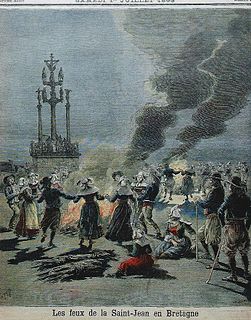 W
WSaint John's Eve, starting at sunset on 23 June, is the eve of celebration before the Feast Day of Saint John the Baptist. The Gospel of Luke states that John was born six months before Jesus; therefore, the feast of John the Baptist was fixed on 24 June, six months before Christmas according to the old Roman calculation. This feast day is one of the very few saints' days which commemorates the anniversary of the birth, rather than the death, of the saint being honored.
 W
WSati or suttee was a historical Hindu practice, in which a widow sacrifices herself by sitting atop her deceased husband's funeral pyre.
 W
WThe Sechseläuten is a traditional spring holiday in the Swiss city of Zürich celebrated in its current form, usually on the 3rd Monday of April, since the early 20th century.
 W
WA smoking ceremony is an ancient custom among some Aboriginal Australians that involves smouldering various native plants to produce smoke. This herbal smoke is believed to have cleansing properties and the ability to ward off bad spirits. In traditional, spiritual culture, smoking ceremonies have been performed following either childbirth or initiation rites involving circumcision. More recently, elements of smoking ceremonies have been incorporated into Welcome to Country performances.
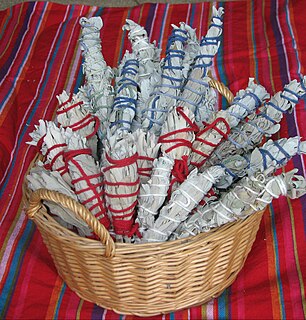 W
WSmudging generally refers to the practice of burning herbal material. It can be done for practical reasons or for spiritual or ceremonial purposes.
 W
WThe Thimithi or firewalking ceremony is a Hindu festival originating in Tamil Nadu, South India that is celebrated a week before Deepavali, during the month of Aipasi of the Tamil calendar. The fire-walking ceremony is in honour of the goddess Draupati Amman, who is considered the incarnation of goddess Mariamman, and is practiced not only in India, but also in Fiji, Sri Lanka, Singapore, Malaysia, Mauritius, Réunion, South Africa and other countries with large South Indian populations.
 W
WUp Helly Aa is a type of fire festival held annually from January to March in various communities in Shetland, Scotland to mark the end of the yule season. Each festival involves a torchlit procession by squads of costumed participants that culminates in the burning of an imitation Viking galley. The largest festival held in Lerwick, Shetland's capital, involves a procession of up to a thousand guizers who march through the streets of Lerwick on the last Tuesday in January. The other rural festivals see lower numbers of participants in accordance with their lower populations.
 W
WVijayadashami also known as Dussehra, Dasara or Dashain, is a major Hindu festival celebrated at the end of Navaratri every year. It is observed on the tenth day in the Hindu calendar month of Ashvin, the seventh month of the Hindu Luni-Solar Calendar, which typically falls in the Gregorian months of September and October.
 W
WWalpurgis Night, an abbreviation of Saint Walpurgis Night, also known as Saint Walpurga's Eve, is the eve of the Christian feast day of Saint Walpurga, an 8th-century abbess in Francia, and is celebrated on the night of 30 April and the day of 1 May. This feast commemorates the canonization of Saint Walpurga and the movement of her relics to Eichstätt, both of which occurred on 1 May 870.
 W
WWang Ye worship is a Fujianese and Taiwanese folk religion, frequently considered an aspect of the Taoist belief system. Wang Ye is particularly worshiped in Southern Taiwan.
 W
WA wicker man was a large wicker statue reportedly used by the ancient Druids for sacrifice by burning it in effigy.
 W
WThe Yule log, Yule clog, or Christmas block is a specially selected log burnt on a hearth as a Christmas tradition in regions of Europe, particularly the United Kingdom, and subsequently the Americas. The origin of the folk custom is unclear. Like other traditions associated with Yule, the custom may ultimately derive from Germanic paganism.